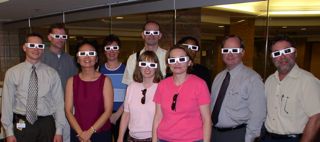
The VR gurus at the University of Michigan took us on a short trip into their realm a couple of days ago (just before the power failure!). They demonstrated three viewing options for their VRML files: The Cave, a rear projection screen, and standard web VRML plugins like the Cosmo player.
The Cave is a huge cubical room, about 10 feet on a side, with one wall removed. Each wall is a rear projection screen, except the floor, which gets its image from a mirrored projection unit placed in the ceiling (at least the mirror is – I am not sure where the projection came from.) The offset images are polarized, apparently they are alternated about 100 times a second, so if you view them without glasses, you will see a slightly doubled image. The viewpoint is determined by the “leader” who wears a set of polarized glasses (kind of like Oakleys on steroids) wired into the system. When the leader turns their head, the perspective – and separation of the images – changes to suit them. The glasses have shutters on each eye -they alternate open and shut, in sync with the image. The 3D effect is quite good. Everyone else in the room wears shuttered lenses also, but not wired in, so the viewpoint may be a little off for some. They demonstrated an architectural model of “the Barcelona House”, and a human heart.
Continue reading
